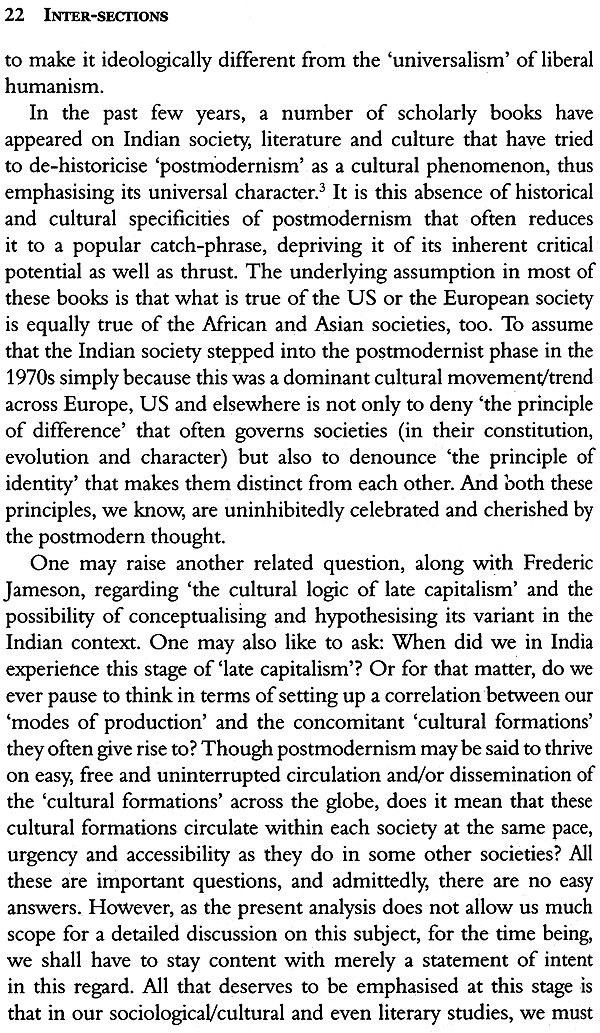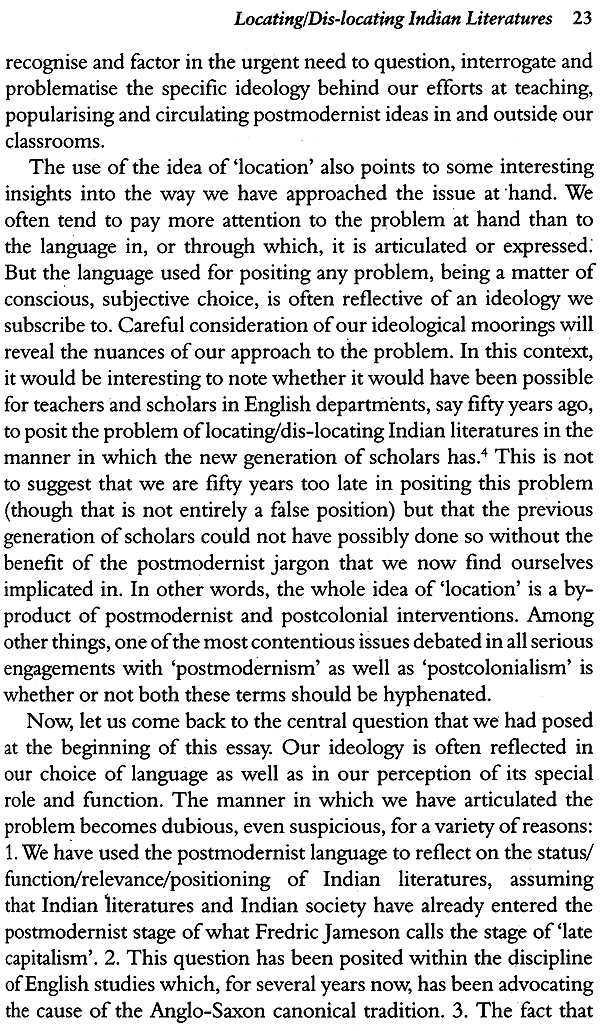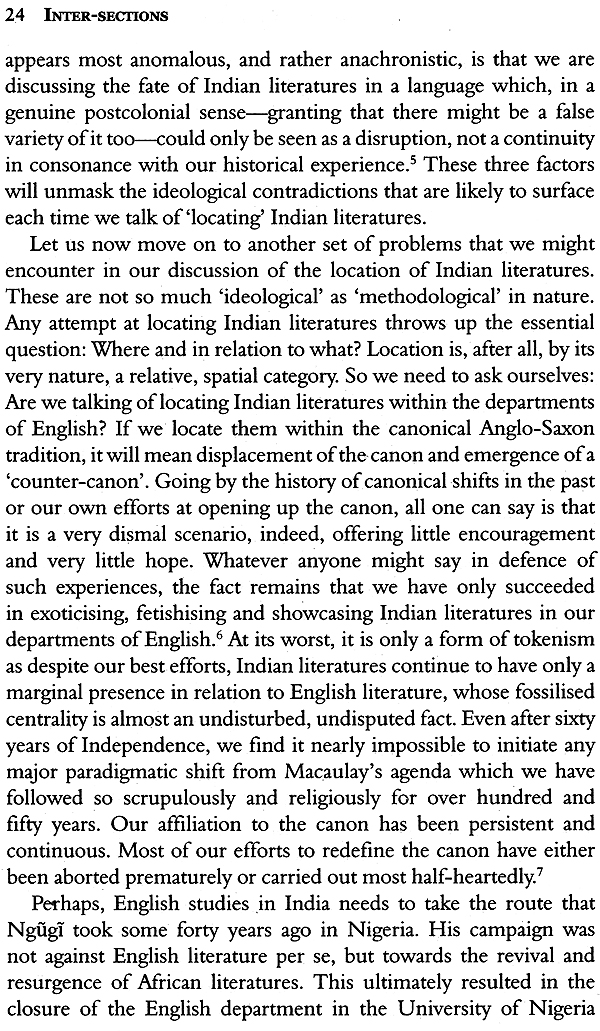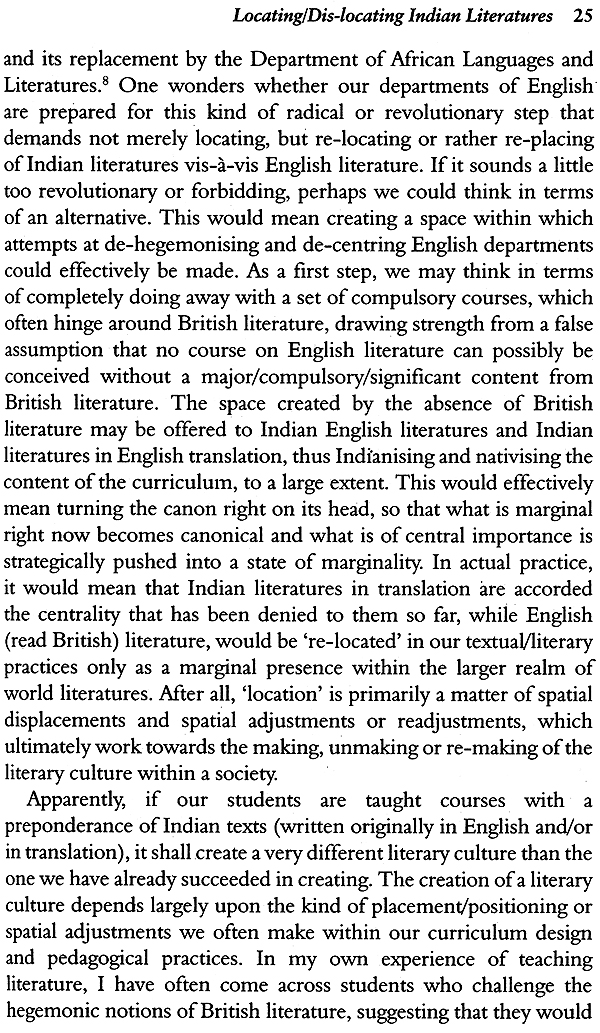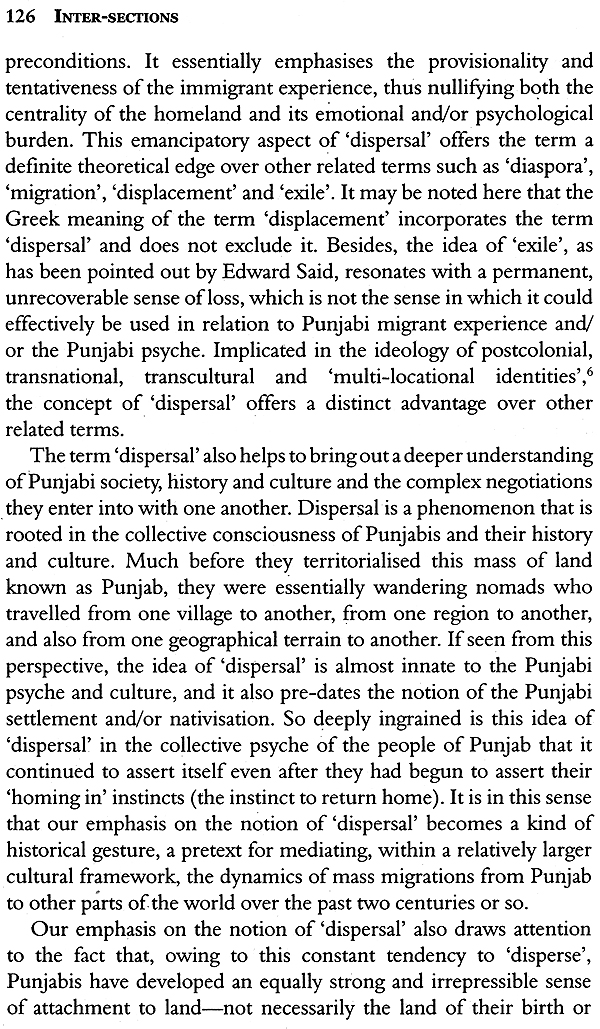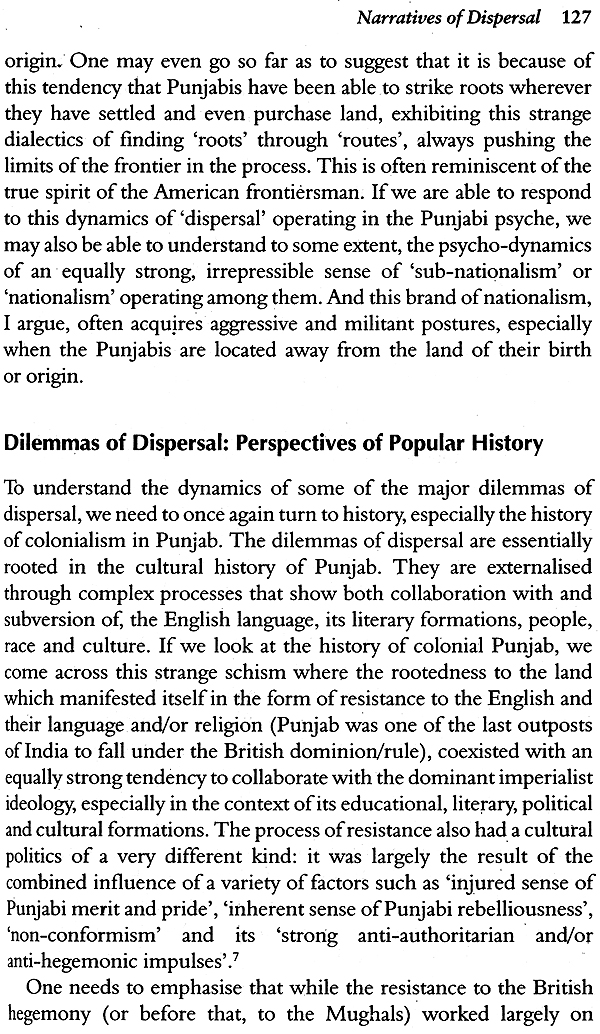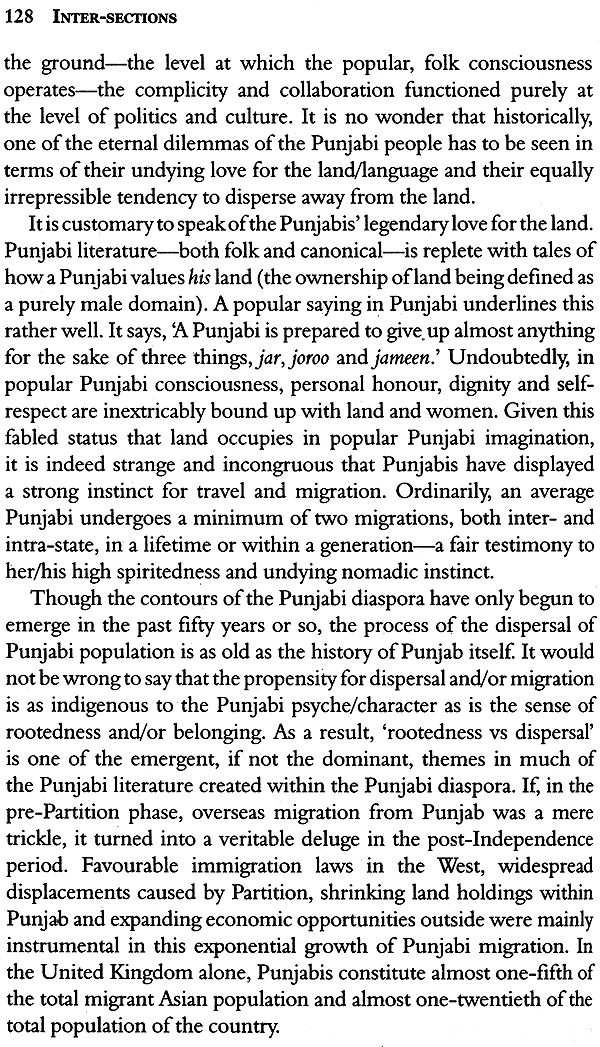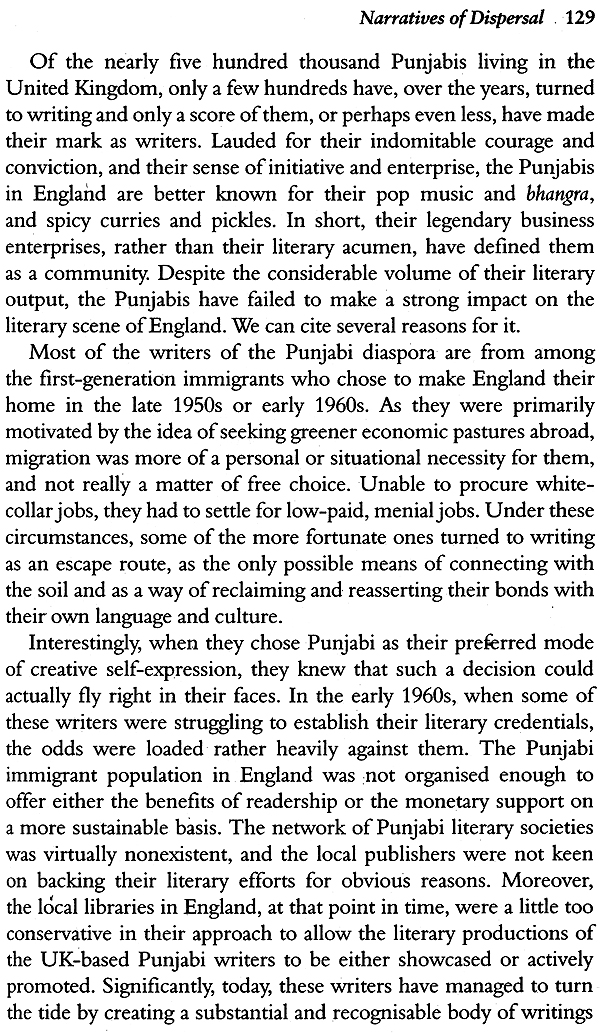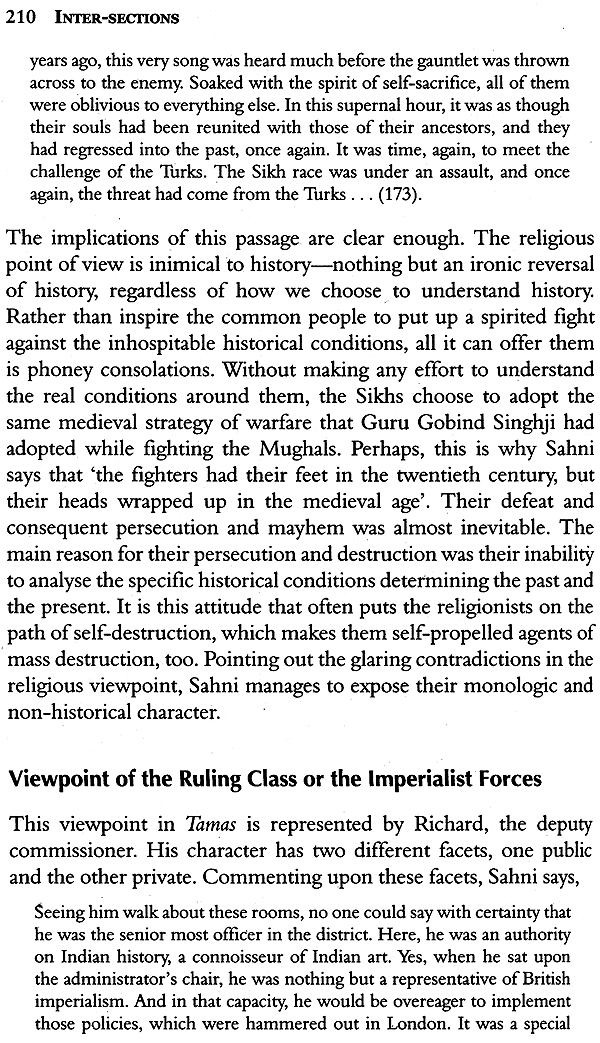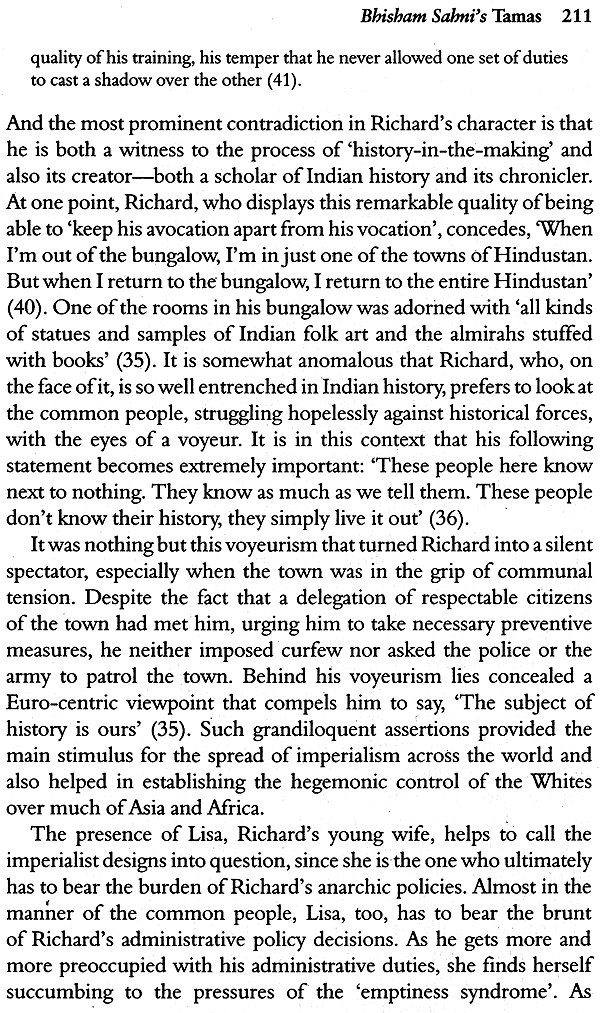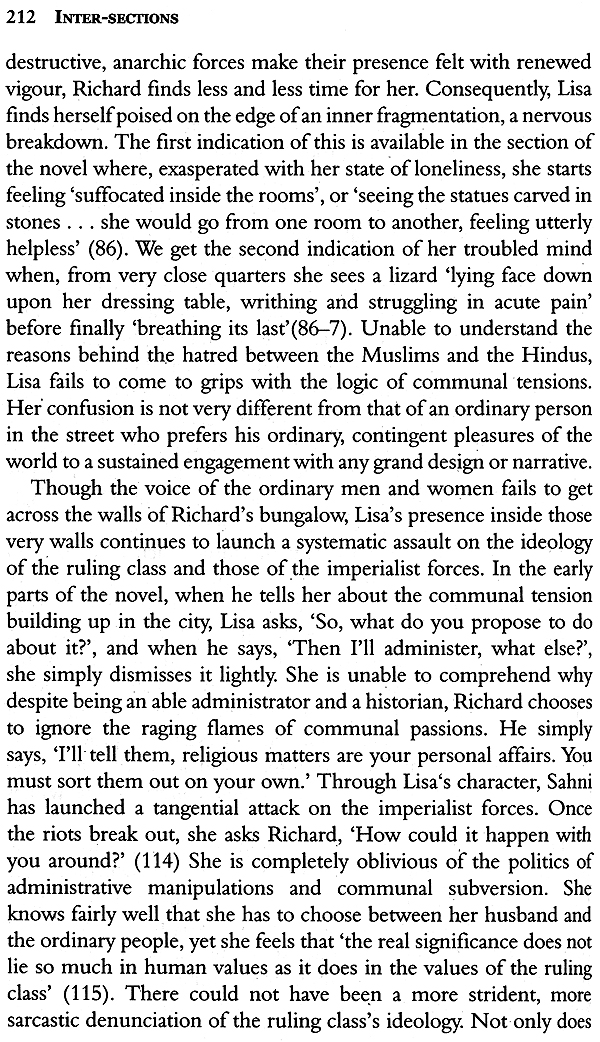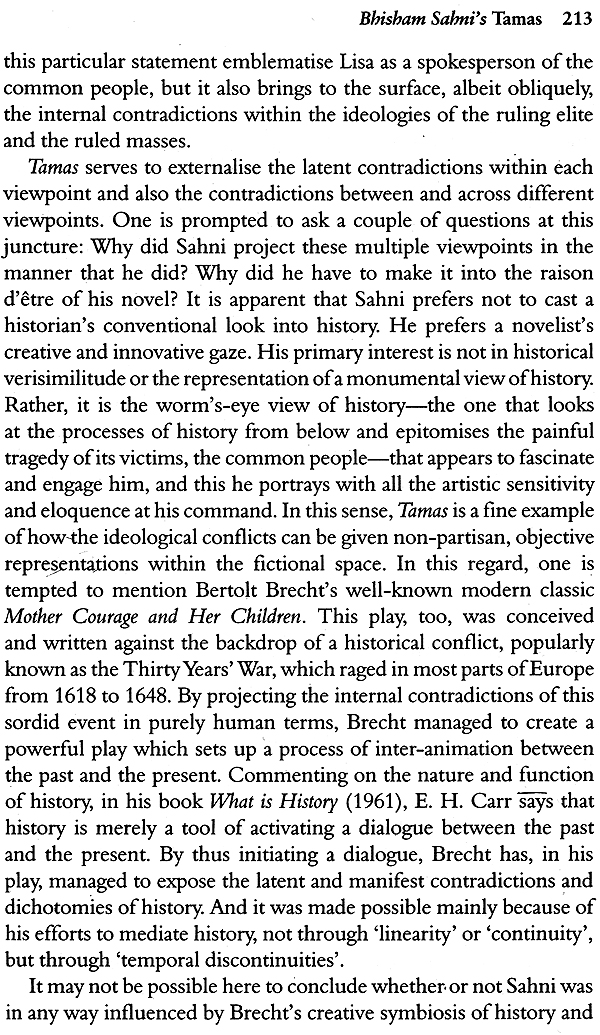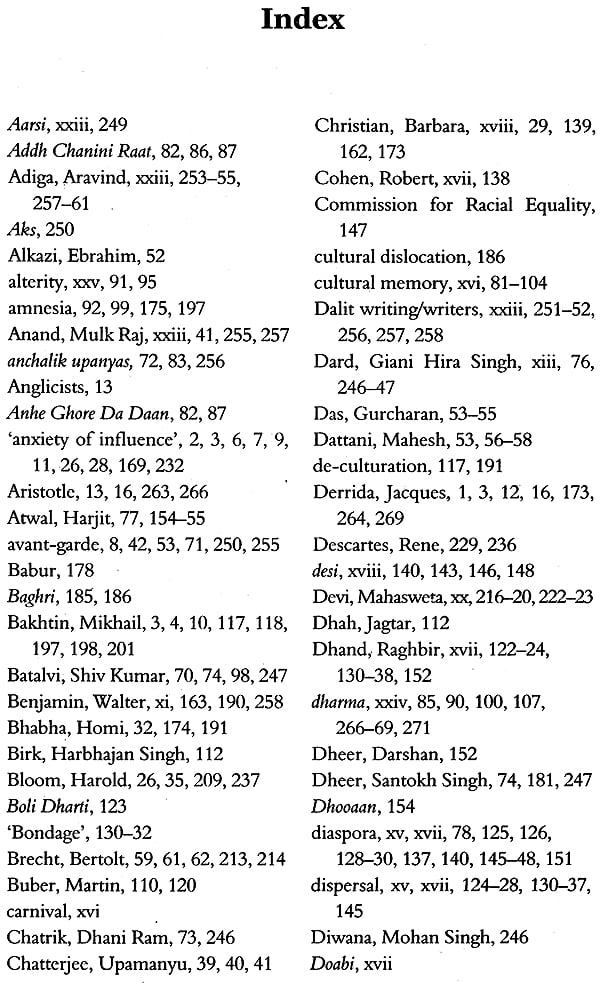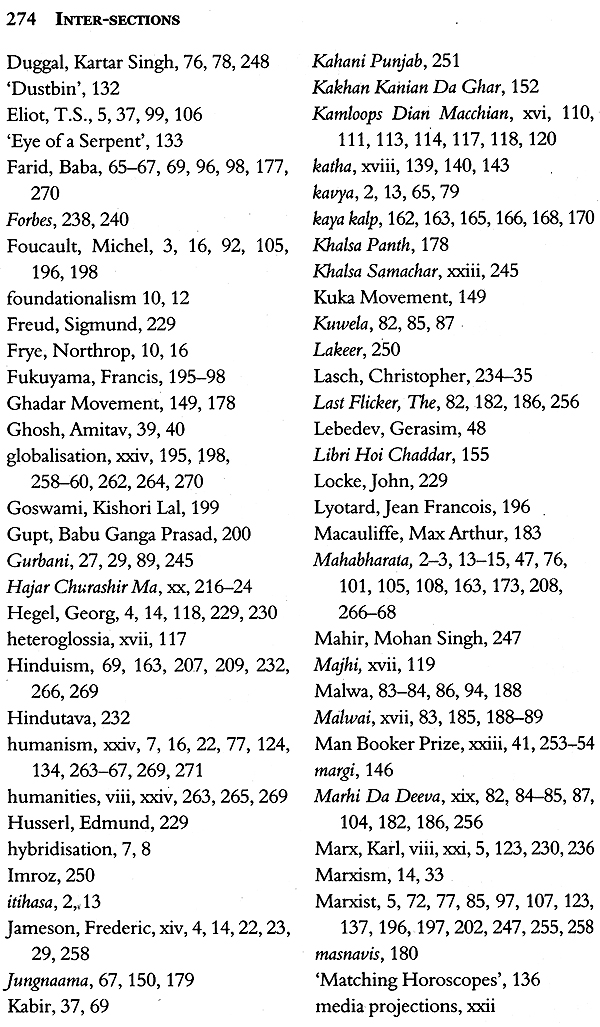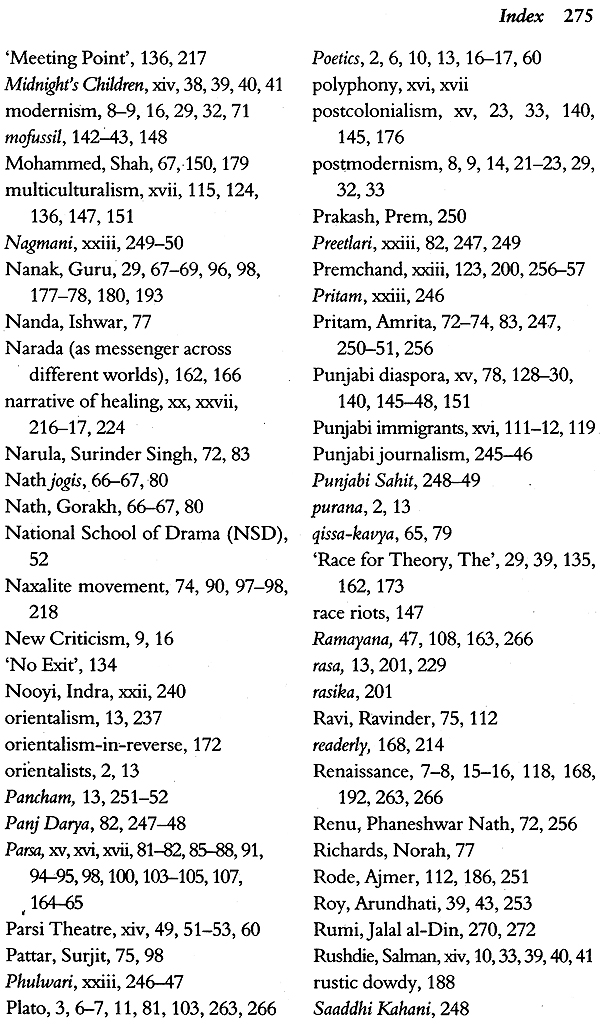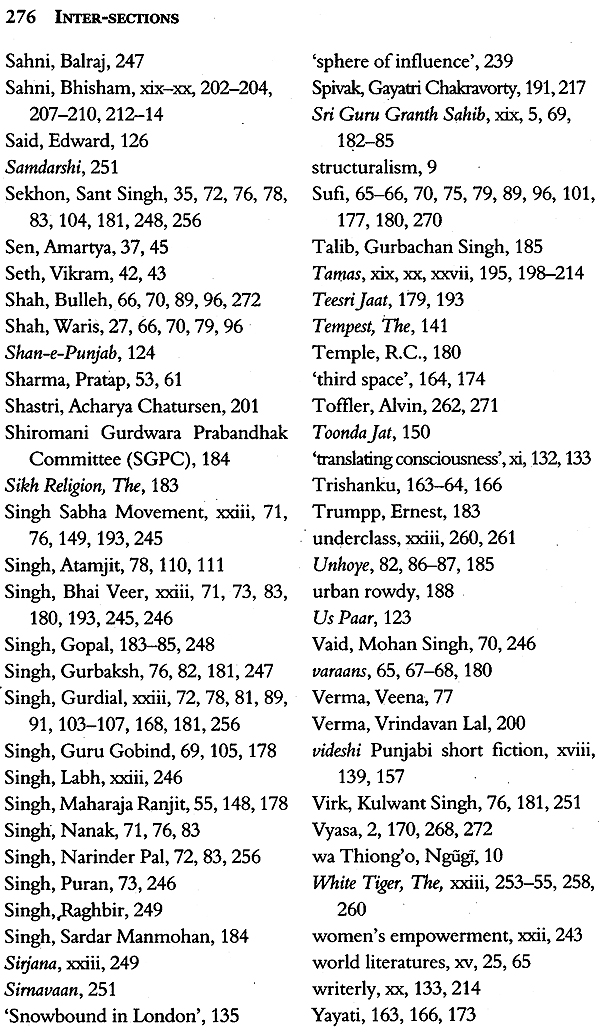
Inter-Sections (Essays on Indian Literature, Translations and Popular Consciousness)
Book Specification
| Item Code: | NAG060 |
| Author: | Rana Nayar |
| Publisher: | Orient Blackswan Pvt. Ltd. |
| Language: | English |
| Edition: | 2012 |
| ISBN: | 9788125045540 |
| Pages: | 303 |
| Cover: | Paperback |
| Other Details | 8.5 inch X 5.5 inch |
| Weight | 290 gm |
Book Description
About the Book
Inter-sections brings together a collection of discursive essays that deal with a range of contemporary issues-from the history of literary genres to the future of humanities; from locating Indian literatures to mapping Indian English fiction and drama; from Punjabi literature, history and culture to the theory and practice of translation; from media-driven literary evaluation to multiple ways of shaping popular consciousness. Divided into four (inter)sections, these essays raise some fundamental questions regarding our postcolonial, postmodern era and emphasise the need for an interdisciplinary approach to mediate both thought and knowledge. The easy, accessible, non-pedantic style of these essays is bound to engage scholars as well as lay readers.
About the Author
Rana Nayar is Professor and Chairperson at the Department of English and Cultural Studies, Punjab University, Chandigarh. The recipient of a Sahiotya Akademi prize for translation and a Charles Wallace India Trust Fellow, Nayar's main areas of interest include theatre, translation studies, and literary and cultural theory. He has translated several modern classics of Punjabi literature into English, and has acted in and directed over twenty theatre productions. Among his other publications are Edward Albee: Towards a Typology of Relationships and Breathing Spaces, a collection of poems.
Preface
In our postcolonial, postmodern world, it has become fashionable to hyphenate words, and even bracket them into smaller segments. Those of us who have fed ourselves on a rich diet of theory find it almost impossible to resist this tendency to put words under erasure. In a way, language has become so self-reflexive that it constantly nudges and teases us into playing with it, just the way a child plays with toys. To my mind, it is the consumerist streak in our post modernity that makes most of us regress into such child-like postures-insistently demanding, perpetually dissatisfied and constantly mulling over a new prank. After all, there is something about the very nature of language that almost demands that we use it in a certain impish, playful way. Having lost its transparency and communicability, language has acquired layers upon layers of sedimentation, making our task as communicators, at once, both frustrating and challenging. In my search for a book title-which, for me personally, is not just another name but a loaded signifier-if I have settled for a hyphenated version of 'Intersections'('Inter-sections'), it is not a quirky decision, but a careful one; as it instantly helps us focus on the interdisciplinary nature of this volume. Besides, it also draws attention towards the diverse body of ideas that this collection engages with.
This title also has a personal significance for me, as it, at once, puts me on the crossroads of life and career, from where I may be able to cast a tangential look at the road receding into the past and stretching beyond the immediate. It was perhaps Sudhir Kakar, the famous psychoanalyst, who once said that as one approaches one's middle age, one tends to become less of a' hunter' and more of a 'fruit gatherer'. One of the conscious symptoms of this 'enigmatic arrival' is that one begins to gather all the disparate, scattered work one has compulsively been doing over the years, without being aware of its future possibilities. Shorn of all vain hopes and false expectations, it is only in middle age that one tends to develop a very different perspective on life that often compels an honest, searching and realistic self-appraisal. Standing atop a plateau and grappling with the reality of what one really is and what one is never likely to become, one does begin to discern an identifiable, recognizable pattern in one's life as well as work. It was this recognition of a definite pattern in the essays written over the last eight years or more that gave me both confidence and courage to put them together in this collection.
All through my academic career, I have self-consciously resisted the tendency (which may also be a professional hazard for some) to produce books only because I was expected to. Somehow, ever since the University Grants Commission (UGC) started insisting that university teachers must produce a certain number of papers to earn their next promotion, academic writing has 'become an industry, driven by the principle of mass production. Books and articles are churned out a dime a dozen, and that too, at an amazing speed, as though straight off the conveyor belt. While it may have led to an unprecedented quantitative growth of academic publications across university departments, it has certainly not helped the cause of qualitative growth. In our postmodern world, where surface reality is all that matters, perhaps it is not just difficult but almost impossible to set up an equitable equation between quality and quantity-something that Karl Marx had sought to do in the nineteenth century. It is. no wonder that so much of eminently unreadable and un publishable material gets produced ever so often that it hardly profits those who read it, and of course, much less those who produce it. All this brouhaha apart, our universities have so far neither produced, nor are likely to produce in the near future, a great scientist or an economist, a potential or an actual Nobel Laureate!
I honestly believe that a book must be created out of our intellectual and emotional convictions, which are not easy to come by, and certainly take a long time to grow and develop. At some point in my academic career, I made a conscious decision to sidestep my primary duty of pursuing active research and focus instead on translation, which had, for a variety of reasons, begun to appear much more meaningful and intellectually stimulating. Around this time, I had increasingly begun to feel that most of the research being done in our universities was neither momentous nor authentic enough. Somehow, being a student of the humanities, I was constantly in search of a more humane way of connecting with my own people, my own language and my own social/cultural context. Every time I thought about English, I found it hard to shed this consciousness of it being a historical burden, a legacy of the colonial rule and hegemony. With time, it became increasingly difficult to shake off this burden, as it slowly became an inseparable part of my professional responsibilities, even my breath and being. So, translation seemed to be the only natural way out of this bind, the only way of harnessing professional knowledge of English in service of my own language and culture-Punjabi.
Though at a superficial level, 'research' and 'translation' may appear to be two distinctly dissimilar and diametrically opposed discourses, both have more in common with each other than is often recognised. Both demand passionate commitment, rigorous mental discipline, a strange amalgam of creative and critical faculties, and above all, a definite sense of purpose and meaning. Perhaps, more than anything else, it was this 'temporary absence of meaning' that had actually put me off research for some time, propelling me towards translation, almost with a vengeance. Thereafter, I spent years together, seeking both personal satisfaction and professional expertise through my several forays into, or should I say, skirmishes with, translation. I must confess that translation is something I learnt as an apprentice and that too, on the job, by testing out my skills on other people's works. It certainly is no mean task to walk in step with another writer's idiom and idiolect, syntactic oddities and ideological preferences. One has to have a fairly high propensity for self-negation, a readiness to examine and interrogate, and if need be, even set aside. one's own linguistic preferences and belief systems. Translation is a highly self-reflexive act, a pretext for excavating layers upon layers of sedimentation surrounding the two linguistic systems that are involved. It may, therefore, be perceived as a definable/indefinable point of 'intersection' between two languages and/or cultures.
There is no denying that despite all the challenges it poses, translation does reserve it's just rewards for anyone who chooses to devote the better part of her/his professional life to it, the way I have done. Though I have absolutely no regrets about the choice I made, somewhere down the line it had begun to dawn on me that I was simply rewriting someone's 'already-written' text. Somewhere in the process of honing my skills as a translator, I had negated myself to such an extent that it had begun to threaten my sense of subjectivity. It is ironic that it was translation that had initially helped me constitute my identity as a translator or reclaim my subject position or subjectivity, but it was translation again that, through all those years, slowly submerged my identity as a researcher. It was almost as though I was on an undeclared academic holiday or a temporary hibernation for a whole decade and a half, the time I devoted to translation. In a way, like all acts of writing, translation too forces upon the practitioner a mendicant's tactical withdrawal from the temporal, material world and the extent to which it does, it becomes a lonesome journey, a solitary enterprise. Looking back, however, I can say that I have both lost and found myself in, and through, my several works of translation.
All through those years, I somehow managed to retain my filial connection with research, but for all practical purposes, this remained both fitfully sporadic and tenuous. However, when I finally did return to research, it was more like a homecoming, and it happened in a somewhat fortuitous manner. Wrestling with real, material problems of translation, I felt a strong urge to return to theory, to seek answers to some of the nagging questions that had teased or irritated me in my practice. It is my conviction that anyone who wishes to take up translation as a semi-professional vocation (as total professionalism is simply not possible in our situation for a variety of reasons), must treat theory as a posteriori, and not a priori, to his/her own practice. There are several cogent reasons for it. One, the surplus of theoretical baggage often suppresses the instinct for translation. Two, most of the time, a translator has to look for contextual solutions for situational problems, not just pre-given solutions. Three, the narrative structured around the practice of translation always has an inherent theoretical edge to it. In a way, no practising translator worth his salt can actually escape or resist the compulsive theoretical itch for long. Sporadic acts of theorising about translation that surfaced in the introductions, prefaces or overtures I wrote for the texts I translated made my return to research easier.
And yet, it was the return of the 'prodigal', someone who had exhausted-though not necessarily dissipated-all his creative and critical potential. Research was a way of re-energising those lost potentials, a way of reclaiming a professional identity and ironically, once again it happened at the intersection of the practice and theory of translation. It is no wonder that I have chosen to include several essays in this volume that either deal directly with my 'translating consciousness' or have emerged out of my engagement with its theoretical implications. Significantly, my reasons for choosing the 'discursive essay' for articulating my thoughts go a long way towards underlining a certain strategic essentialism built into them. Despite its waning popularity, I do look upon this genre as the best form of self-expression, which must somehow be kept alive, if it has to ensure the ultimate survival of the dialogic tradition in our culture. Situated at the conjuncture of its argumentative and philosophical variants, a discursive essay combines the best of both. It communicates without overwriting itself and often goes straight to the heart of the matter, without offering any apologies. Ever since theory invaded our academia, it has become fashionable to regard heavily jargon-ridden critical discourse as a preferred mode of expression. I have always maintained that jargon never facilitates, only disrupts; it never makes discourse accessible, only stifles it.
However, these 'inter-sections' become real only to the extent to which they become effective interventions into the existing body of knowledge. While some may think that these interventions are a direct consequence of an overvaluation of my own work, the others may treat them simply as gratuitous acts of self-glorification. It is true that some amount of overvaluation is necessary for any author to sustain the illusion of being in the profession. It is also a fact that writing invariably draws its 'life' or its 'afterlife' (to borrow Walter Benjamin's famous phrase) from the involvement of the reader. In its simplest form, writing is a form of social contract between a writer and a reader, a leap of faith between two individuals that easily posits unlimited dialogic possibilities. Now, this is regardless of whether or not two individuals in this social contract actually believe in the reality of each other's existence. After the famous pronouncement of Roland Barthes about the proverbial 'death of the author'-both in the literal and metaphorical sense-it has become increasingly difficult to argue that 'author' has any substantive 'reality' or 'subjectivity' of her/his own. While the author's reality may always remain suspect or simply inaccessible, the reader may still be able to recover or reclaim her/his identity through volitional and involved acts of reading.
At this juncture, a word about the methodology and conscious (or unconscious) aims of this particular collection, by way of an overture to my readers, would certainly be in order. This volume is neatly divided into four (inter-)sections-Reading Indian and Indian English Literatures, Punjabi Literature: Some Contexts and Texts, Reading Translation(s), and Power, Hegemony and Mass Media: Case Studies in Popular Consciousness. The essays have been arranged thematically, keeping in mind the quintessential requirements of the areas of study, their distinctive operational logic as well as their distinctive constraints. This has been done with the consciousness that areas of overlap and interpenetration are bound to emerge as the essays unfold slowly across the four sections. While selecting essays for each section, my effort was to put together pieces that reflect a broad range and spectrum of issues falling within each category, thus enabling me to cover as much theoretical ground within that specific category as possible. Though each essay offers an understanding of a distinct idea, issue or problem and so is discrete, it does ultimately fit into the larger frame of each section, by virtue of its emphases, ideological imperatives and perspectival values. This internal logic of each micro-section may just as well be applied to the larger macro-frame of the volume, too.
This volume begins with a Prologue-'Notes towards the History/Theory of Genres'. It was delivered as a keynote address in a seminar on the history of genres organised by the Department of Punjabi, Punjabi University, Patiala, in March 2008. Though I do not have much expertise in the area 'of genre studies, this essay is a collocation of random thoughts I could be said to have gathered along my way. This tentativeness is definitely reflected in the way the essay is diffidently or self-consciously titled. Of course, I was consciously thinking of Eliot's Notes towards the Definition if Culture (whose resonance is found in the title) as a model for working out my own framework, but inspiration for the ideas came primarily from my occasional readings and, of course, long hours of teaching. In this Prologue, I have tried to demonstrate that the history of genres is as old as the history of human thought itself Further, I argue that the principles of differentiation, classification and/or segmentation began to be applied around the time that the need was felt to separate the 'secular' from the 'religious'. Since the advent of theory, we have moved into a phase where either the history of different genres is being rewritten or the rigid boundaries across genres are gradually being pulled down, making way for the interpenetration of these categories.
The first section begins with the essay 'Locating/Dis-locating Indian Literatures: A Metacritical Narrative', an attempt to look into the problematic of how and where Indian literatures could possibly be located vis-a-vis Indian English literature. More than a mere superficial exercise in comparative literature, the essay addresses several theoretical problems that the Indian context throws up in this regard. At the same time, an effort has also been made to incorporate some empirical observations to give the necessary cutting edge to these theoretical problems. Though this paper emerged largely out of a national seminar on Indian English literature hosted by our department at ICSSR Chandigarh in 2000, it shows a definite imprint of how postmodern theories have influenced our lives and thought. In the postmodern context, the term 'location' has come to enjoy a very loaded, multiple signification. In a way, if any single development is to be linked to the historical twist from the 'modern' to the 'postmodern', it is the 'spatialisation' of our narratives. In this situation, we are often compelled to examine the contesting/competing claims of the local vs the global, the native vs the immigrant, the citizen vs the state. If this framework has been preferred, it is only because it permits us to interrogate some of the well-known institutional practices, operating both inside and outside the academia.
In 'Re-contextualising the Post-1980s Indian Novel in English', first delivered as a keynote address in a national seminar at HMV Jalandhar in September 2007, the effort has been to create a new context within which some of the recent Indian English novels, especially those produced after Salman Rushdie'sMidnight's Children, could possibly be read or critiqued. Over the years, it has become fashionable for the West to hail every other work of an Indian English novelist as a unique literary experiment. This has somehow coincided with the ever-growing shrillness emanating from the 'end of history' rhetoric. Somehow, this whole argument surrounding the 'end-ism' seems unacceptable, as one must, following Frederic Jameson, 'always historicise'. Following this logic, I have tried to historicise the re-emergence or revival of Indian English fiction of the early 1980s, perceiving this development within the larger frame of what was happening in Europe or the US in the late 1960s or the early 1970s. Perhaps, the novels of Salman Rushdie and others of his tribe deserve to be seen against the backdrop of Gunter Grass and Gabriel Marquez, who had introduced 'magical realism' in fiction much earlier. In a way, the purpose of this essay is to create a counter-discourse, thereby offering a corrective to the perspective of the Western reader and critic, who often deny Indian English fiction the sense of history it certainly possesses.
'Emerging Trends in Post-Independence Indian English Drama' is another one of the historical gestures of the kind that I have already mentioned. The only difference is that this time round, my focus is not so much upon fiction as on drama. This essay is a reworked version of a seminar paper presented at GGS Khalsa College, Ludhiana, in January 2008. My argument here is that Indian . English drama has remained, for a variety of reasons, a neglected area within the larger domain of Indian English literature. While both fiction and poetry in Indian English show a definite propensity for identifiable trends and movements, the same cannot be said about drama with equal force and conviction. Apart from mapping out the major developments that have emerged in this particular field since Independence, this essay also casts a tangential look at the logistics of why this particular genre has remained peripheral and/ or neglected. There is also an attempt here to contextualise some of the early developments in this field within the broader frame of Parsi theatre, which is said to have influenced the whole range of urban theatre forms in various regional Indian languages, especially in the pre-Independence phase. In a way, my effort is to identify and delimit the points of intersection between regional urban theatres and the English theatre in India with its specific metropolitan orientation and bias.
In the second section, the focus of the volume ostensibly shifts away from Indian and Indian English literatures to Punjabi literature, but the main' objective of this section is to explore the points of conjuncture between these two .discourses. The essays here deal with Punjabi literature from the perspective of an outsider. Whether it is the question of mapping out the history of Punjabi literature or deconstructing the ideology behind the Indian variants of postcolonial ism, these essays invariably lack the 'inwardness' often associated with an insider. As I have functioned all along within the Western paradigms and/or critical frameworks, my perception of Punjabi literature is bound to be qualitatively different from that of a Punjabi teacher/scholar. If, on the one hand, it has enabled me to locate Punjabi literature within a much wider frame of world literatures, on the other, it has helped me step out of the self- enclosed world of Punjabi scholarship and re-formulate my critical hypotheses on very different terms. To an extent, this is reflected in the way in which I have been able to read Gurdial Singh's Parsa from the perspective of cultural memory or discover an entirely new semantics for Punjabi diaspora literature in the form of a less popular notion of 'dispersal'. The last essay in this section, which seeks to locate the conjunctures and dis-junctures within Punjabi diaspora literature, again, falls in this category.
In the first essay, 'Punjabi Literature through the Prism of History', the original version of which was published in Tile Book Review (August 2007),' the attempt is to provide a synoptic view of the history of Punjabi literature, spanning a thousand years or more, in less than twenty pages. Apart from the compactness of style and economy of expression, what really marks out this essay is its critical sharpness and wealth of historiographical material. Though it does not really emerge as a conscious aim in the construction of this essay, one of its avowed purposes is to interrogate the all-too-familiar notions of historiography that Punjabi literary traditions often foreground. Inured to the changes in the realm of historiography, most of the literary histories in Punjabi appear to follow the foundational notions of history as an objective science, based upon the twin principles of chronology and factual documentation. In my essay, I have consciously tried to escape this tyranny of conventional modes of recording history by foregrounding the notion of 'cultural history'. More than the discipline of history, it is 'literary history' that must aspire to become 'people's history' by recording their struggles, hardships and dilemmas emerging out of their contact with, or contestation of, historical forces. The extent to which this essay succeeds in doing so, it becomes a tour de force in anti-foundational views of history.
From the notion of cultural history to the concept of 'cultural memory', the progression is both natural and inevitable. Though I had translated Gurdial Singh's famous novel Parsa way back in 1999, it took me several years to read the inscriptions of cultural memory in this particular novel. It was an invitation to participate in an international conference on the theme, 'Punjabi Literature and Its Worlds', held at the University of British Columbia, Vancouver, in April 2008, which finally enabled me to crystallise my thoughts on this subject. This paradigm of cultural memory came into critical focus in the post-World War II context, especially when systematic attempts were being made to recover the traces of collective memory from the individual writings of German Jews who had suffered persecution at the hands of Hitler and his allies. It was through such exercises that the repressed contents of history came to the fore, thus deconstructing the conventional modes of 'history- making'. The retrieval or reclamation of cultural memory, therefore, becomes an act of individual as well as sociaVcollective catharsis and responsibility. Of late, the genre of novel is increasingly being used, especially in Latin America, Africa and Asia, as a site for excavating the archaeology of repressed human knowledge. It is against this backdrop that I have attempted to re-read Gurdial Singh's Parsa.
In the third essay of this section, titled Atamjit Singh's Kamloops Dian Macchian: Polyphonic Discourse and Dramatic Art', I have taken recourse to Bakhtinian ideas to interpret a Punjabi play that deals with the eternal dilemmas and conflicts of Punjabi immigrants in Canada. Though Bakhtin has largely theorised about the novel and the novelistic discourse, his ideas such as 'polyphony', 'carnival' and 'heteroglossia' have much wider applications. For instance, more than the novel, it is drama that could be seen as an effective location for polyphony and heteroglossia, as also for defining the limits of the dialogic discourse. His deft and creative use of various Punjabi dialects makes Atamjit's play most appropriate for the application of Bakhtinian ideas. He mainly uses three different dialects-Majhi, Malwai and Doabi-in the speech rhythms of his characters-apparently, an interesting experiment in heteroglossia. The polyphonic effect achieved through the orchestration of different voices has further implications for the multi-lingual character and the identity politics of the Canada-based Punjabi diasporic community. It also has far-reaching consequences for the ways in which multiple dialogic possibilities have been projected-both within the community, and also in relation to the Canadian brand of multiculturalism. This essay establishes, rather unambiguously, how all of this ultimately has a cascading effect upon the construction of the play.
In 'Narratives of Dispersal: Reading Raghbir Dhand's Stories', I return to a deconstructive reading of Dhand's stories, preferring Robert Cohen's notion of 'dispersal' over the notion of'diaspora' (a more widely used term in postcolonial discourse) for analysis. Over the years, the term 'diaspora', by virtue of its archaeological thickness, has become hegemonic, foregrounding the twin notions of 'forced exile' and the 'scattering of the Jews across the globe'. However, in the case of Jews, the notion of 'homeland' has a fixed centre and fairly stable boundaries, something that is not necessarily the case with Punjabis. For them, 'homeland' has been a mythic, 'wished-for' land and much less a real, historical or geographical space and/or territory. In fact, the configurations of the Punjabi homeland have constantly been shifting, so much so that it is practically impossible to draw even a rough map of its boundaries. This process of constant 'mythification' of homeland coupled with the idea of 'voluntary exile' is what sets the historical process of the Punjabi immigration apart from that of the other communities and! or races. So, one of the effective ways of exploring the diasporic tensions in Raghbir Dhand's stories is to read them as narratives of dispersal. It is the notion of dispersal that captures the endless process of decentring that the Punjabi community has experienced right through its history.
The last essay included in this section, titled 'Postcolonial Katha: Continuities and Ruptures in Videshi Punjabi Short Fiction', offers some very interesting points of intersection endorsed by our contemporary discourse. Most of these may be outlined in such apparently dichotomous though problematic terms as 'colonial' and 'postcolonial', 'theory' and 'narrative', 'English' and 'Punjabi', 'continuity' and 'rupture', 'native' and 'immigrant', and finally, 'des;' and 'videshi'. The essay is structured around different sets of polarities, with a conscious aim of turning them inside out or upside down. Proceeding on the assumption that katha, an Indian variant of narrative, is a significant tool of theorisation (following the lead of Barbara Christian, who, as a Black American scholar, perceives Western critical theory as an expression of White supremacy), have sought to create a discourse of resistance in this essay. Rather than turn to the pre-given, critical framework of postcoloniality supplied by the Western academia, my effort has been to build up a sustained critique from below. For this purpose, I have also looked searchingly into the problematic of how human knowledge is first constructed and then circulated, disseminated or legitimised, both inside and outside the academia. This is what provides me with an alternative frame of reference within which I have tried to situate and/or critique a fair sampling of diasporic Punjabi short fiction. The third section has four essays selected and arranged in such a way that the section reflects its concern with both the theory and practice of translation. The essay, 'Author as Translator: Paradigms and Possibilities in the Indian Context', was originally delivered as a valedictory address at a national seminar on 'Author as Translator', hosted by Jamia Millia Islamia, New Delhi, in March 2008. More in the nature of a speculative essay, it provides us a sketchy outline of various paradigms and possibilities that tend to emerge out of the dialogic interaction between the author and the translator. Some of the possibilities debated in this essay are as follows: an author translating his own work or that of another author, an author translating from one Indian language into another or from one Indian language into another European language and vice versa. Each possibility apparently has its own distinctive rationale and logistics. The second part of the essay directs my search towards some indigenous tropes of translation to be found in the form of metaphors, legitimised by narratives that may ultimately help us redeem the Indian discourse on translation. Once again, my effort has been to escape the tyranny of the dominant discourse by resisting Western theories of translation and consciously moving towards a discourse of alterity.
The second essay, 'Punjabi and English: Mediating the History of Language, Literature and Translation', was originally written for a seminar organised by the Sahitya Akademi, New Delhi, in January 2006. It seeks to map out the historical relationship between Punjabi and English in terms of language, literature and translation. It needs to be pointed out here that I have self-consciously chosen not to construct this understanding of history in orthodox, conventional terms, but instead foregrounded the Foucauldian gaps and fissures, while exploring the rich terrain of literary and cultural archives and/or the popular folk consciousness inscribed in the local idioms, phrases and proverbs. The contours of this historical frame inevitably coincide with the extended phase of British colonial rule in India, when most Indian languages and literatures, including Punjabi, had begun to develop their multiple points of conjuncture and disjuncture with the English language, literature and culture. Building up on the asymmetrical transactions between Punjabi and English, this essay also externalises the 'politics of translation' that often results from it. This point is further corroborated by examining the manner in which two of the seminal texts of Punjabi culture, one religious and the other secular-Sri Guru Granth Sahib and Gurdial Singh's Marhi Da Deeva-have been translated into English. This essay throws up a wide range of questions about the theory and practice of translation that deserve our attention, particularly in the Indian context.
The third essay-'Bhisham Sahni's Tomas: Multiple Historical Perspectives and Literary Art'-was originally commissioned by the editor of Desh Pardes, a well-known Hindi literary journal, sometime in 2002, for a special issue on Sahni. So, it was originally written in Hindi and much later, it was translated into English and published elsewhere. Like all other translated texts, this essay too is twice- borri, and so is an interesting study of how the problems pertaining to the theory and practice of translation must always be discussed in relation to each other. This makes this essay an ideal piece to be included in this section, although its real focus is not translation, but the new trends in historiography and its multiple implications for Tamas as well as other works of Hindi fiction. My concern here is with the question of 'how' and 'how successfully' has Sahni managed to depart from the conventional ways of representing history. In the process, I have also tried to establish linkages between Sahni's fictional strategy of multiple perspectivism and his art of writing. His ingenious and creative use of fictional strategies transforms this novel from just another 'historical fiction' into a well-crafted 'writerly text' (to borrow Roland Barthes' phrase), complete with its penchant for religious openness and linguistic plurality.
The last essay included in this section, again, does not necessarily deal with the trope of translation, though it does use a translated text for the purposes of analysis. In 'Mahasweta Devi's Hajar Churashir Ma: A Narrative of Healing', originally presented as a seminar paper at G.G.S. College, Ludhiana, in 2004, I have discussed four different types of narratives which may also be treated as paradigms for historicising the feminist discourse. My main focus in this essay, however, is upon the intermediate form of 'narrative of healing' which could be said to become a bridge, as it were, between a 'narrative of oppression' and a 'narrative of self-liberation'. My argument is that before a woman is able to attain a measure of autonomy or reclaim her 'subjectivity', she has to go through an extended phase of actual or my thopoeic (as may be the case) process of self-healing, enabling her to recover from the multiple inflictions of oppression. Drawing upon my understanding of Mahashweta Devi's oeuvre that appears to vacillate between the twin extremities of the 'primitive' and the 'civilized', the 'tribal and the 'bourgeoisie', which she negotiates apparently with an ideological aim of re-constituting them, I have offered an existential-aesthetic and political reading of one of her well-known works. By reversing the popular dictum that 'the personal is political', I have argued how Hajar Churashir Ma is about the politicisation of Brati's mother, a process that first helps her recover her subjectivity, her humaneness, and then provides her with inner, spiritual healing, a necessary pre-condition for self-liberation.
In the last section of this volume, the focus shifts away from literature and translation to the ideological influences of mass media and their implications for popular consciousness. Over the years, I have done substantial amount of journalistic writing in the belief that as teachers, it is our duty to communicate not only to our students inside the classroom, but also to the general public and the society at large. If, on the one hand, it is simply not possible for us to impose any definite 'limits on the process of communication in this globalised world, on the other, a teacher is always conscious of her/his role as a 'thinking being', who must rarefy, clarify and also circulate ideas, wherever s/he possibly can. One of the good things about journalistic writing is that it imposes a very rigorous mental discipline upon all those who practise it. Above all, it teaches the virtues of brevity, compactness and economy to a teacher who may otherwise be given to this sin of 'over-writing'-more of a professional hazard than anything else. In my case, incursions into journalism have helped me develop sensitivity towards the invisible reader out there (who always remains anonymous in all known forms of mass media). Besides, it has enabled me to look at the complex processes of communication in a more self-conscious and self-reflexive way. To some extent, this is reflected in all the essays I have selected for inclusion in the present volume.
The first essay in this section, 'Of Language, Consciousness and Mass Media', is an attempt to look into different ways of negotiating the complex relationship among three discrete though interdependent categories-language, consciousness and mass media. First, I have tried to build on the ideas of Martin Heidegger and Karl Marx to identify two distinct philosophical and historical ways of negotiating the relationship between language and consciousness. In the process, I have identified two theoretical configurations of this relationship-the phenomenological and the materialist. My purpose in conceptualising these two categories is to theorise on the changes that have come about in the print media, one of the prominent organs of mass media, especially in the Indian context. My contention is that after liberalisation, Indian newspapers have gone through a phase of restructuring their role and function-from the role of 'opinion-makers' they have fast turned into products of consumption. It is this co modification that is the real source of the crisis of credibility in our print media. Here, my main effort is to unmask various dimensions of this crisis and also establish how newspapers have largely become purveyors of mass culture. This argument has also helped me understand the manifold contradictions inherent in mass culture, and its subversive ideological implications for both language and consciousness. In the second essay, 'Of Influence, Power and Empowerment', which was first published in the Economic and Political Weekly in November 2007, I look at the nature and content of media projections and argue that such projections have to be viewed with a great deal of scepticism, caution and care. This is all the more important when such projections have to do with issues as complex as women's empowerment or gender politics. When Indra Nooyi was named the CEO of a multinational company based in the US, the media hailed her elevation as a major victory for the cause of women's empowerment. What really intrigued me was the fact that a simple, somewhat naive, equation was being set up between her personal success and women's empowerment. This is what prompted me to critique the whole idea of media projections as a subversive strategy that enters into a silent collusion with capitalist forces which ultimately control, manipulate and regulate the media in more ways than one. My contention is that women's empowerment becomes possible only if an individual uses her personal influence or power or both to either initiate women-friendly schemes/policies or offer greater opportunities to women within the organisation, thus widening the base of their collective influence and power. Individual success is dependent upon a number of incremental factors, all of which may not have anything to do with gender politics or women's empowerment.
Contents
| Preface | vii | |
| Author's Acknowledgements | xxvi | |
| Prologue: Notes towards the History/Theory of Genres | 1 | |
| Reading Indian and Indian English Literatures | ||
| 1 | Locating/Dis-locating Indian Literatures: A Metacritical Narrative | 21 |
| 2 | Re-contextualising the Post-1980s Indian Novel in English | 36 |
| 3 | Emerging Trends in Post-Independence Indian English Drama | 46 |
| Punjabi Literature: Some Contexts and Texts | ||
| 4 | Punjabi Literature through the Prism of History | 65 |
| 5 | The Novel as a Site of Cultural Memory: Gurdial Singh's Parsa | 81 |
| 6 | Atamjit Singh's Kamloops Dian Macchian: Polyphonic Discourse and Dramatic Art | 110 |
| 7 | Narratives of Dispersal: Reading Raghbir Dhand's Stories | 122 |
| 8 | Postcolonial Katha: Continuities and Ruptures in Videshi Punjabi Short Fiction | 139 |
| Reading Translation(s) | ||
| 9 | Author as Translator: Paradigms and Possibilities in the Indian Context | 161 |
| 10 | Punjabi and English: Mediating the History of Language, Literature and Translation | 175 |
| 11 | Bhisham Sahni's Tamas: Multiple Historical Perspectives and Literary Art | 195 |
| 12 | Mahasweta Devi's Hajar Churashir Ma: A Narrative of Healing | 216 |
| Power, Hegemony and Mass Media: Case Studies in Popular Consciousness | ||
| 13 | Of Language, Consciousness and Mass Media | 227 |
| 14 | Of Influence, Power and Empowerment | 238 |
| 15 | Of Little Magazines in Punjabi: A Historical Overview | 245 |
| 16 | Class, Ideology and Politics of Globalisation: A Case Study of Aravind Adiga | 253 |
| Epilogue: Rediscovering Humanities in Life and Literature | 262 | |
| Index | 273 |
